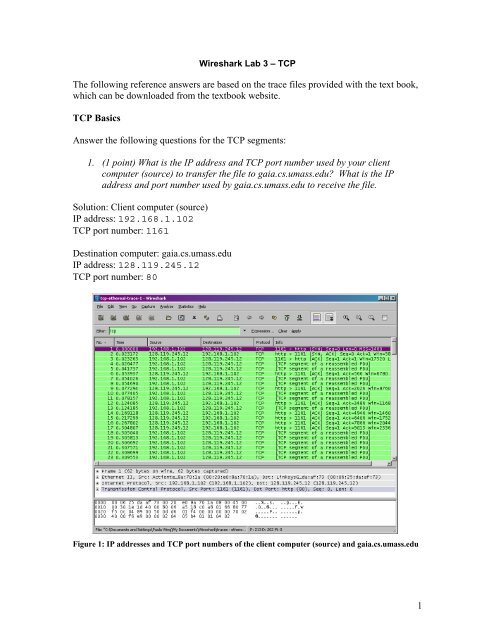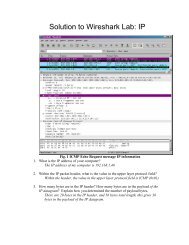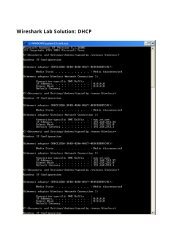Wireshark Lab 3
Wireshark Lab 3
Wireshark Lab 3
Create successful ePaper yourself
Turn your PDF publications into a flip-book with our unique Google optimized e-Paper software.
<strong>Wireshark</strong> <strong>Lab</strong> 3 – TCP<br />
The following reference answers are based on the trace files provided with the text book,<br />
which can be downloaded from the textbook website.<br />
TCP Basics<br />
Answer the following questions for the TCP segments:<br />
1. (1 point) What is the IP address and TCP port number used by your client<br />
computer (source) to transfer the file to gaia.cs.umass.edu? What is the IP<br />
address and port number used by gaia.cs.umass.edu to receive the file.<br />
Solution: Client computer (source)<br />
IP address: 192.168.1.102<br />
TCP port number: 1161<br />
Destination computer: gaia.cs.umass.edu<br />
IP address: 128.119.245.12<br />
TCP port number: 80<br />
Figure 1: IP addresses and TCP port numbers of the client computer (source) and gaia.cs.umass.edu<br />
1
2. (1 point) What is the sequence number of the TCP SYN segment that is used to<br />
initiate the TCP connection between the client computer and gaia.cs.umass.edu?<br />
What is it in the segment that identifies the segment as a SYN segment?<br />
Solution: Sequence number of the TCP SYN segment is used to initiate the TCP<br />
connection between the client computer and gaia.cs.umass.edu. The value is 0 in this<br />
trace.<br />
The SYN flag is set to 1 and it indicates that this segment is a SYN segment.<br />
Figure 2: Sequence number of the TCP SYN segment<br />
3. (2 points) What is the sequence number of the SYNACK segment sent by<br />
gaia.cs.umass.edu to the client computer in reply to the SYN? What is the value<br />
of the ACKnowledgement field in the SYNACK segment? How did<br />
gaia.cs.umass.edu determine that value? What is it in the segment that identifies<br />
the segment as a SYNACK segment?<br />
Solution: Sequence number of the SYNACK segment from gaia.cs.umass.edu to the<br />
client computer in reply to the SYN has the value of 0 in this trace.<br />
2
The value of the ACKnowledgement field in the SYNACK segment is 1. The value of the<br />
ACKnowledgement field in the SYNACK segment is determined by gaia.cs.umass.edu<br />
by adding 1 to the initial sequence number of SYN segment from the client computer (i.e.<br />
the sequence number of the SYN segment initiated by the client computer is 0.).<br />
The SYN flag and Acknowledgement flag in the segment are set to 1 and they indicate<br />
that this segment is a SYNACK segment.<br />
Figure 3: Sequence number and Acknowledgement number of the SYNACK segment<br />
4. (1 point) What is the sequence number of the TCP segment containing the HTTP<br />
POST command? Note that in order to find the POST command, you’ll need to<br />
dig into the packet content field at the bottom of the <strong>Wireshark</strong> window, looking<br />
for a segment with a “POST” within its DATA field.<br />
Solution: No. 4 segment is the TCP segment containing the HTTP POST command. The<br />
sequence number of this segment has the value of 1.<br />
3
Figure 4: Sequence number of the TCP segment containing the HTTP POST command<br />
5. (2 points) Consider the TCP segment containing the HTTP POST as the first<br />
segment in the TCP connection. What are the sequence numbers of the first six<br />
segments in the TCP connection (including the segment containing the HTTP<br />
POST)? At what time was each segment sent? When was the ACK for each<br />
segment received? Given the difference between when each TCP segment was<br />
sent, and when its acknowledgement was received, what is the RTT value for each<br />
of the six segments? What is the EstimatedRTT value (see page 237 in text)<br />
after the receipt of each ACK? Assume that the value of the EstimatedRTT is<br />
equal to the measured RTT for the first segment, and then is computed using the<br />
EstimatedRTT equation on page 249 for all subsequent segments.<br />
Note: <strong>Wireshark</strong> has a nice feature that allows you to plot the RTT for<br />
each of the TCP segments sent. Select a TCP segment in the “listing of<br />
captured packets” window that is being sent from the client to the<br />
gaia.cs.umass.edu server. Then select: Statistics->TCP Stream Graph-<br />
>Round Trip Time Graph.<br />
Solution: The HTTP POST segment is considered as the first segment. Segments 1 – 6<br />
are No. 4, 5, 7, 8, 10, and 11 in this trace respectively. The ACKs of segments 1 – 6 are<br />
No. 6, 9, 12, 14, 15, and 16 in this trace.<br />
4
Segment 1 sequence number: 1<br />
Segment 2 sequence number: 566<br />
Segment 3 sequence number: 2026<br />
Segment 4 sequence number: 3486<br />
Segment 5 sequence number: 4946<br />
Segment 6 sequence number: 6406<br />
The sending time and the received time of ACKs are tabulated in the following table.<br />
Sent time ACK received time RTT (seconds)<br />
Segment 1 0.026477 0.053937 0.02746<br />
Segment 2 0.041737 0.077294 0.035557<br />
Segment 3 0.054026 0.124085 0.070059<br />
Segment 4 0.054690 0.169118 0.11443<br />
Segment 5 0.077405 0.217299 0.13989<br />
Segment 6 0.078157 0.267802 0.18964<br />
EstimatedRTT = 0.875 * EstimatedRTT + 0.125 * SampleRTT<br />
EstimatedRTT after the receipt of the ACK of segment 1:<br />
EstimatedRTT = RTT for Segment 1 = 0.02746 second<br />
EstimatedRTT after the receipt of the ACK of segment 2:<br />
EstimatedRTT = 0.875 * 0.02746 + 0.125 * 0.035557 = 0.0285<br />
EstimatedRTT after the receipt of the ACK of segment 3:<br />
EstimatedRTT = 0.875 * 0.0285 + 0.125 * 0.070059 = 0.0337<br />
EstimatedRTT after the receipt of the ACK of segment 4:<br />
EstimatedRTT = 0.875 * 0.0337+ 0.125 * 0.11443 = 0.0438<br />
EstimatedRTT after the receipt of the ACK of segment 5:<br />
EstimatedRTT = 0.875 * 0.0438 + 0.125 * 0.13989 = 0.0558<br />
EstimatedRTT after the receipt of the ACK of segment 6:<br />
EstimatedRTT = 0.875 * 0.0558 + 0.125 * 0.18964 = 0.0725<br />
second<br />
5
Figure 5: Segments 1 – 6<br />
Figure 6: ACKs of segments 1 - 6<br />
6
Figure 7: Round Trip Time Graph<br />
7
6. (1 point) What is the length of each of the first six TCP segments?<br />
Solution: Length of the first TCP segment (containing the HTTP POST): 565 bytes<br />
Length of each of the other five TCP segments: 1460 bytes (MSS)<br />
Figure 8: Lengths of segments 1 - 6<br />
8
7. (1 point) What is the minimum amount of available buffer space advertised at the<br />
received for the entire trace? Does the lack of receiver buffer space ever throttle<br />
the sender?<br />
Solution: The minimum amount of buffer space (receiver window) advertised at<br />
gaia.cs.umass.edu for the entire trace is 5840 bytes, which shows in the first<br />
acknowledgement from the server. This receiver window grows steadily until a maximum<br />
receiver buffer size of 62780 bytes. The sender is never throttled due to lacking of<br />
receiver buffer space by inspecting this trace.<br />
Figure 9: Minimum receive window advertised at gaia.cs.umass.edu (packet No. 2)<br />
9
8. (1 point) Are there any retransmitted segments in the trace file? What did you<br />
check for (in the trace) in order to answer this question?<br />
Solution: There are no retransmitted segments in the trace file. We can verify this by<br />
checking the sequence numbers of the TCP segments in the trace file. In the Time-<br />
Sequence-Graph (Stevens) of this trace, all sequence numbers from the source<br />
(192.168.1.102) to the destination (128.119.245.12) are increasing monotonically with<br />
respect to time. If there is a retransmitted segment, the sequence number of this<br />
retransmitted segment should be smaller than those of its neighboring segments.<br />
Figure 10: Sequence numbers of the segments from the source (192.168.1.102) to the destination<br />
(128.119.245.12)<br />
10
9. (1 point) How much data does the receiver typically acknowledge in an ACK?<br />
Can you identify cases where the receiver is ACKing every other received<br />
segment (see Table 3.2 on page 257 in the text).<br />
Solution: The acknowledged sequence numbers of the ACKs are listed as follows.<br />
acknowledged sequence number acknowledged data<br />
ACK 1 566 566<br />
ACK 2 2026 1460<br />
ACK 3 3486 1460<br />
ACK 4 4946 1460<br />
ACK 5 6406 1460<br />
ACK 6 7866 1460<br />
ACK 7 9013 1147<br />
ACK 8 10473 1460<br />
ACK 9 11933 1460<br />
ACK 10 13393 1460<br />
ACK 11 14853 1460<br />
ACK 12 16313 1460<br />
…<br />
The difference between the acknowledged sequence numbers of two consecutive ACKs<br />
indicates the data received by the server between these two ACKs. By inspecting the<br />
amount of acknowledged data by each ACK, there are cases where the receiver is<br />
ACKing every other segment. For example, segment of No. 80 acknowledged data with<br />
2920 bytes = 1460*2 bytes.<br />
11
Figure 8: Cumulative ACKs (No. 80, 87, 88, etc) where the receiver is ACKing every other received<br />
segment.<br />
10. (2 points) What is the throughput (bytes transferred per unit time) for the TCP<br />
connection? Explain how you calculated this value.<br />
Solution: The computation of TCP throughput largely depends on the selection of<br />
averaging time period. As a common throughput computation, in this question, we select<br />
the average time period as the whole connection time. Then, the average throughput for<br />
this TCP connection is computed as the ratio between the total amount data and the total<br />
transmission time. The total amount data transmitted can be computed by the difference<br />
between the sequence number of the first TCP segment (i.e. 1 byte for No. 4 segment)<br />
and the acknowledged sequence number of the last ACK (164091 bytes for No. 202<br />
segment). Therefore, the total data are 164091 - 1 = 164090 bytes. The whole<br />
transmission time is the difference of the time instant of the first TCP segment (i.e.,<br />
0.026477 second for No.4 segment) and the time instant of the last ACK (i.e., 5.455830<br />
second for No. 202 segment). Therefore, the total transmission time is 5.455830 -<br />
0.026477 = 5.4294 seconds. Hence, the throughput for the TCP connection is computed<br />
as 164090/5.4294 = 30.222 KByte/sec.<br />
12
11. (2 points) Use the Time-Sequence-Graph (Stevens) plotting tool to view the<br />
sequence number versus time plot of segments being sent from the client to the<br />
gaia.cs.umass.edu server. Can you identify where TCP’s slowstart phase begins<br />
and ends, and where congestion avoidance takes over? Solution: TCP Slow Start<br />
begins at the start of the connection, i.e., when the HTTP POST segment is sent<br />
out. The identification of the TCP slow start phase and congestion avoidance<br />
phase depends on the value of the congestion window size of this TCP sender.<br />
However, the value of the congestion window size cannot be obtained directly<br />
from the Time-Sequence-Graph (Stevens) graph. Nevertheless, we can estimate<br />
the lower bound of the TCP window size by the amount of outstanding data<br />
because the outstanding data is the amount of data without acknowledgement. We<br />
also know that TCP window is constrained by the receiver window size and the<br />
receiver buffer can act as the upper bound of the TCP window size. In this trace,<br />
the receiver buffer is not the bottleneck; therefore, this upper bound is not quite<br />
useful to infer the TCP window size. Hence, we focus on the lower bound of the<br />
TCP window size.<br />
From the following table, we cannot see that the amount outstanding data increases<br />
quickly at the start of this TCP flow; however, it never exceeds 8192 Bytes. Therefore,<br />
we can ensure that the TCP window size is larger than 8192 Bytes. Nevertheless, we<br />
cannot determine the end of the slow start phase and the start of the congestion avoidance<br />
phase for this trace. The major reason is that this TCP sender is not sending data<br />
aggressively enough to push to the congestion state. By inspecting the amount of<br />
outstanding data, we can observe that the application at most sends out a data block of<br />
8192 bytes. Before it receives the acknowledgement for the whole block of these 8192<br />
bytes, the application will not send more data. It indicates before the end of the slow start<br />
phase, the application already stops transmission temporally.<br />
13
Type No. Seq. ACKed seq. Outstanding data<br />
Data 4 1 565<br />
Data 5 566 2025<br />
ACK 6 566 1460<br />
Data 7 2026 2920<br />
Data 8 3486 4380<br />
ACK 9 2026 2920<br />
Data 10 4946 4380<br />
Data 11 6406 5840<br />
ACK 12 3486 4380<br />
Data 13 7866 5527<br />
ACK 14 4096 4917<br />
ACK 15 6006 3007<br />
ACK 16 7866 1147<br />
ACK 17 9013 0<br />
Data 18 9013 1460<br />
Data 19 10473 2920<br />
Data 20 11933 4380<br />
Data 21 13393 5840<br />
Data 22 14853 7300<br />
Data 23 16313 8192<br />
ACK 24 10473 6732<br />
ACK 25 11933 5272<br />
ACK 26 13393 3812<br />
ACK 27 14853 2352<br />
ACK 28 16313 892<br />
ACK 29 17205 0<br />
Data 30 17205 1460<br />
Data 31 18665 2920<br />
Data 32 20125 4380<br />
Data 33 21585 5840<br />
Data 34 23045 7300<br />
Data 35 24505 8192<br />
ACK 36 18665 6732<br />
ACK 37 20125 5272<br />
ACK 38 21585 3812<br />
ACK 39 23045 2352<br />
ACK 40 24505 892<br />
ACK 41 25397 0<br />
Data 42 25397 1460<br />
Data 43 26857 2920<br />
Data 44 28317 4380<br />
Data 45 29777 5840<br />
14
Data 46 31237 7300<br />
Data 47 32697 8192<br />
ACK 48 26857<br />
ACK 49 28317<br />
ACK 50 29777<br />
ACK 51 31237<br />
ACK 52 33589<br />
Data 53 33589 6732<br />
Data 54 35049 5272<br />
Data 55 36509 3812<br />
Data 56 37969 2352<br />
Data 57 39429 892<br />
Data 58 40889 0<br />
ACK 59 35049 6732<br />
ACK 60 37969 3812<br />
ACK 61 40889 892<br />
ACK 62 41781 0<br />
Data 63 41781 1460<br />
Data 64 43241 2920<br />
Data 65 44701 4380<br />
Data 66 46161 5840<br />
Data 67 47621 7300<br />
Data 68 49081 8192<br />
ACK 69 44701 5272<br />
ACK 70 47621 2352<br />
ACK 71 49973 0<br />
Data 72 49973 1460<br />
Data 73 51433 2920<br />
Data 74 52893 4380<br />
Data 75 54353 5840<br />
Data 76 55813 7300<br />
Data 77 57273 8192<br />
ACK 78 52893 5272<br />
ACK 79 55813 2352<br />
ACK 80 58165 0<br />
Data 81 58165<br />
Note that the criteria to determine the end of slow start and the beginning of the<br />
congestion avoidance is the way how congestion window size reacts to the arrival of<br />
ACKs. Upon an ACK arrival, if the congestion window size increases by one MSS,<br />
TCP sender still stays in the slow start phase. In the congestion avoidance phase, the<br />
congestion window size increases at 1/(current_congestion_window_size). By<br />
inspecting the change of the congestion window upon the arrival of ACKs, we can<br />
infer the states of the TCP sender.<br />
15
12. (2 points) Comment on ways in which the measured data differs from the<br />
idealized behavior of TCP that we’ve studied in the text.<br />
Solution: The idealized behavior of TCP in the text assumes that TCP senders are<br />
aggressive in sending data. Too much traffic may congest the network; therefore, TCP<br />
senders should follow the AIMD algorithm so that when they detect network congestion<br />
(i.e., packet loss), their sending window size should drop down. In the practice, TCP<br />
behavior also largely depends on the application. In this example, when the TCP sender<br />
can send out data, there are no data available for transmission. In the web application,<br />
some of web objects have very small sizes. Before the end of slow start phase, the<br />
transmission is over; hence, the transmission of these small web objects suffers from the<br />
unnecessary long delay because of the slow start phase of TCP.<br />
16





